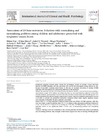| dc.identifier.citation | Hou, M., Herold, F., Werneck, A. O., Teychenne, M., Delli Paoli, A. G., Taylor, A., Van Damme, T., Kramer, A. F., Hossain, M. M., Yeung, A. S., Owen, N., Gerber, M., Ludyga, S., Cheval, B., & Zou, L. (2024). Associations of 24-hour movement behaviors with externalizing and internalizing problems among children and adolescents prescribed with eyeglasses/contact lenses. International Journal of Clinical and Health Psychology, 24(1), 100435. https://doi.org/10.1016/j.ijchp.2023.100435 | en |
| dc.description.abstract | Background: Emerging evidence points towards the psychological benefits of meeting 24-hour movement behavior (24-HMB) guidelines, but such associations have not yet been investigated among children and adolescents of prescribed eyeglasses/contact lenses. To this end, we examined associations of meeting 24-HMB guidelines with internalizing and externalizing challenges in this population.
Methods: We used data from the 2021 National Survey of Children's Health, a cross-sectional survey including a representative sample of US children and adolescents. Data on movement behaviors (physical activity [PA], sedentary behavior operationalized via screen time [ST], and sleep duration [SL]) and internalizing and externalizing problems were collected through caregiver proxy reports. Caregivers completed questionnaires for 6030 (2799 girls) US children and adolescents of prescribed eyeglasses/contact lenses. Logistic regression analyses were conducted to determine the above-presented associations.
Results: Only 7.1 % of those prescribed eyeglasses/contact lenses met all three 24-HMB guidelines, while they were more likely to meet SL guideline alone (32.1 %) in relation to other independent guidelines including PA (2.5 %) and ST (10.9 %). Compared to not meeting any of the three 24-HMB guidelines, meeting at least two guidelines (25.22 %) was significantly linked to lower odds of internalizing problems and externalizing problems.
Conclusion: Meeting at least two components of the 24-HMB guidelines was beneficially linked to internalizing and externalizing problems. Thus, strategies or intervention programs that focus on meeting 24-HMB guidelines should be implemented among children and adolescents of those prescribed eyeglasses/contact lenses to foster coping with psychological issues. | en |
